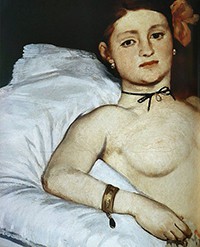As “modern life” became a favoured subject for artists in the second half of the 19th century, coinciding with the Second Empire in France, the focus of the Musée d'Orsay's new exhibition in Paris “Splendour and Misery. Pictures of Prostitution, 1850-1910” is the shady world of prostitution and how it was intricately intertwined with the development of modern painting.
Manet's “Olympia” (widely recognised as a portrait of a prostitute), is a famous example of how a still unacceptable subject matter combined with a shockingly fresh technique (free brushstrokes and strong lighting) scandalised the salon when it was shown there for the first time in 1865.
Brothels which had been legalised in 1804 began to disappear largely by the latter half of the century and the “Brasseries à femmes” began to proliferate and “women of the night” became more visible on the streets lit by gas-lamps and later by electricity. From Manet's images of the Opera, the terrain of the “demi-mondaines” (high-class prostitutes), to Degas's behind-the-scenes depictions of prostitutes waiting for clients in brothels, the depiction of these women became a central theme for a whole new generation of painters.
As the detailed presentation (in English) of the exhibition points out, ‘the verb “to prostitute oneself” literally means “to display or to expose oneself publicly” so it is hardly surprising to see that the worlds of art and prostitution are conflated in the 19th and early 20th century imagination. The metamorphosis of the body of the prostitute – “an object of public pleasure” – into a work of art to be viewed by all was effected through the artifices of seduction. Studied poses revitalised the repertoire of traditionally accepted forms in the academic register, and make-up (also described as ‘face paint') and coloured stockings were an excuse for a riot of colours in the paintings of Kupka, Derain, Van Dongen, Rouault and Picasso.'
More information on the website of the Musée d'Orsay.
A catalogue is available (in English).
The exhibition is accompanied by a program of concerts (1 October 2015 – 12 january 2016), Musée d'Orsay, Auditorium niveau -2
A series of filmed Operas From Manon to Carmen is also programmed at the auditorium of the Musée d'Orsay as part of the season:
Manon Sun 27 September 2015 – 15h00
La Traviata Sun 4 October 2015 – 15h00
Carmen Sun 11 October 2015 – 15h00
La Périchole Sun 18 October 2015 – 15h00
Musée d'Orsay
Auditorium niveau -2
The Café Polisson, which opens the Splendour and Misery cycle, brings together the cruel and amusing songs of the Belle Epoque:
Thursday 24 September 2015 – 20h30
Sat 3 October 2015 – 16h00
Sat 10 October 2015 – 16h00
Thu 15 October 2015 – 20h30
Musée d'Orsay
Auditorium niveau -2
Langue(s) : English/French


